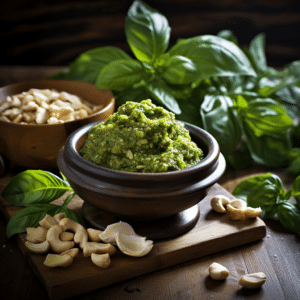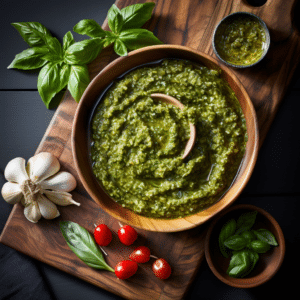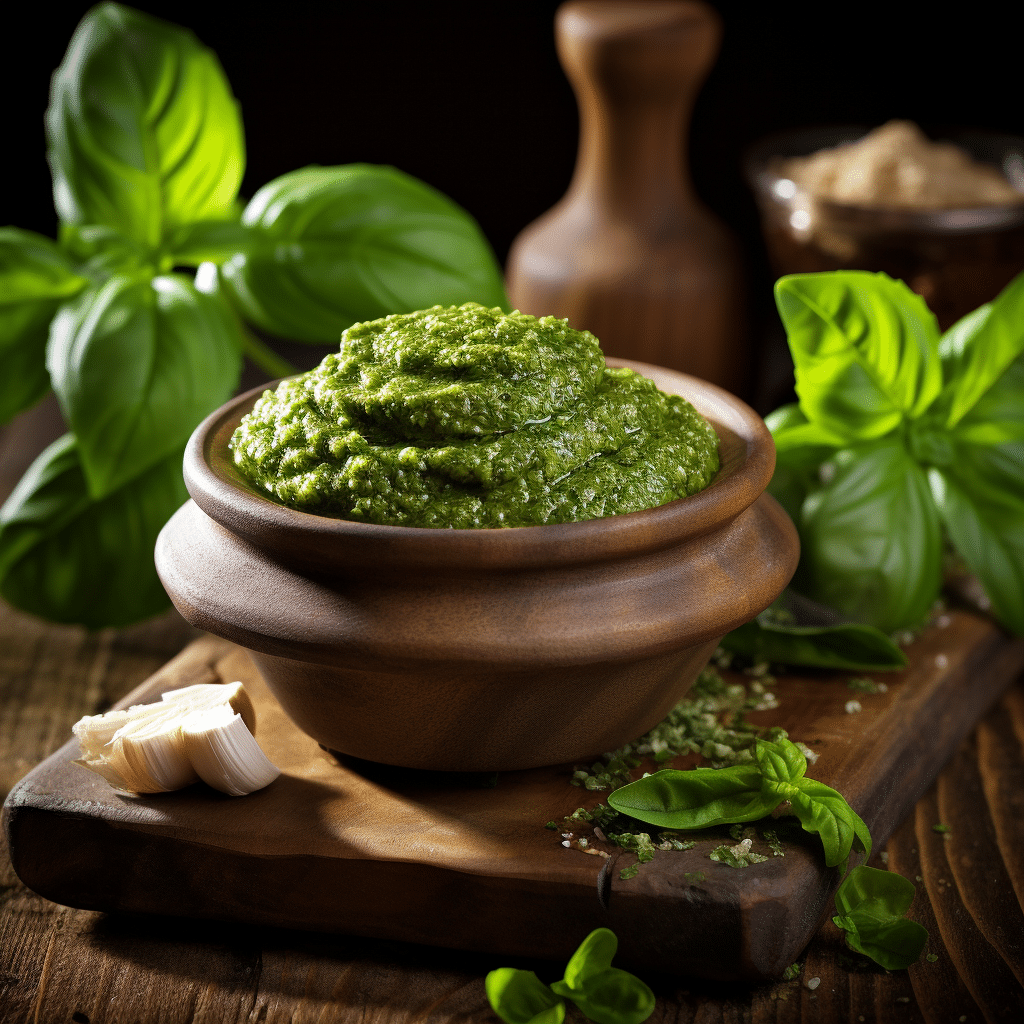Exploring the Taste and Uses of Pesto Sauce
Pesto: Taste, Texture, and Culinary Uses Unveiled Anytime pesto is mentioned, many people remember the iconic pesto alla Genovese, a sauce made from fresh basil, parmesan cheese, pine nuts, and garlic. Pesto originated from Genoa in Liguria, Italy, and is famous worldwide.
There are many ways of using pesto in culinary. And how you plan to use this sauce will depend on the flavor you desire in your meal. This leads to the question, what does pesto taste like? This article discusses pesto, how it tastes like, its texture, appearance, how it’s made, and the different ways of using it in cooking.

What Does Pesto Taste Like?
Pesto taste like basil and garlic but with a creamy texture. The creamy texture comes from cheese and a bit of pine nuts used. The olive oil also adds richness and an earthy flavor to pesto. When well prepared, you should be able to get the taste of each individual ingredient distinctly. No component should be too muted or too dominant over others.
Thinking of pesto brings up images of basil leaves with garlic and pine nuts crushed into a creamy sauce. And the best way to describe its taste is a mild herby flavor with hints of garlic and pine nuts. Pesto can sometimes have crushed red bell pepper and black peppercorns to enhance its flavor.
What Is The Texture Of Pesto?
The authentic texture of pesto is somewhere between smooth and overly crunchy. When using a blender to make pesto, it’s easy to make the mistake of making pesto’s texture uniformly smooth. To avoid this and ensure you get the texture right, consider using a mortar and a pestle.
Pesto should be creamy and thick or on the thinner side. Either way, you want to ensure you have added all the ingredients in their proper proportions for the flavor to be rich and balanced. You can also modify the sauce’s texture depending on how many basil leaves, nuts, and liquid ingredients you have. But remember, the more liquid (lemon juice or olive oil) you add to the pesto, the thinner the texture.
But no matter the amount of liquid you add to the sauce, remember to do so slowly. This ensures the texture of the sauce becomes finer, whether thin or thick.
About Pesto And How It’s Made
Pesto is an Italian sauce characterized by its bright green color. This Italian sauce obtained its name from the term “pestare,” which means to crush. So, the name refers to the method of its preparation which involves grinding the ingredients.
There are a couple of ways of making pesto. However, the traditional way of making pesto sauce uses basil leaves, garlic, pine nuts, pecorino or parmesan cheese, salt, and olive oil. The ingredients are put in a marble mortar and are then crushed using a wooden pestle.
Since garlic and pine nuts take longer to crush, they are the first ingredients to go in the mortar. Once they are completely crushed, basil leaves and salt are then added. The crushing goes on, and once the basil is crushed, cheese and olive oil are added, enhancing the sauce’s texture and flavor.
Some people may find the crushing of ingredients exhausting and time-consuming. If you fall in this category and own a blender, simply mix all ingredients in the blender and blend. Alternatively, you can buy pesto sauce from stores if the thought of making your own doesn’t sit well with you.
How Can You Use Pesto?
Although the most popular way of using pesto is with pasta, there are several other ways of using this sauce. Since pesto is salty, buttery, and peppery, it can be an excellent flavor enhancer for many dishes. For instance, you can use pesto in the following:
- To make breakfast eggs
- As a pizza topping
- To bake pesto bread
- To prepare pesto-crusted salmon
- As a topping for roasted vegetables
- As a sauce for steak, chicken, pork chops, etc
Is Pesto Healthy
As seen, there are numerous ways of using pesto sauce. And besides it being versatile, it is healthy. Pesto is loaded with calories but packed with essential nutrients. Here are the health benefits of the ingredients used in making pesto.
Basil – being the main ingredient used in pesto, basil is nutrient-rich and an excellent source of antioxidants. The essential oils and antioxidants in basil leaves are known to lower blood sugar levels and hinder the growth of harmful bacteria.
Garlic: Garlic is another healthy herb used in abundance in pesto. These ingredients help lower cholesterol, act as a natural antibiotic, and improve brain function.
Pine nuts – these look like small pinecones harvested from stone pine trees and pinyon pine trees. These nuts are an easy way to add protein, vitamin E, magnesium, and iron to this green sauce.
Extra virgin olive oil – olive oil is an excellent source of essential and healthy fatty acids and antioxidants. Studies suggest that the antioxidants in olive oil have been shown to reduce the risk of specific cancers.
How To Store Pesto
How to store pesto depends on whether the pesto is store-bought or homemade.
Store-Bought Pesto
For unopened store-bought pesto, you can store it in the same condition as in-store, mostly at room temperature. Remember to keep away from direct sunlight and heat sources when storing pesto at room temperatures. A kitchen cupboard or the pantry is a good storage place.
If opened, seal the store-bought pesto’s lid tightly after use and store it in the fridge. If the original pesto container is damaged, transfer the source to another well-fitting jar and refrigerate.
Homemade Pesto
Homemade pesto should always be kept in the fridge, whether opened or unopened. So, once you’re done making your pesto, transfer it to a container or a jar with a tight sealing lid and refrigerate.

Conclusion
Pesto: Taste, Texture, and Culinary Uses Unveiled Traditional Italian pesto is a thick green sauce that tastes herby and bright from the basil and savory and salty from the pine nuts and cheeses. This sauce is also garlicky with pleasant grassiness from extra virgin olive oil. The bite from the raw garlic flavor can be rounded out by heating the pesto sauce with pasta, vegetables, or meats.






